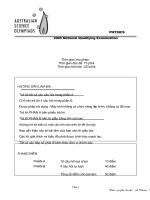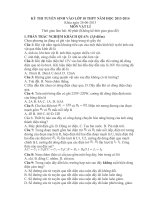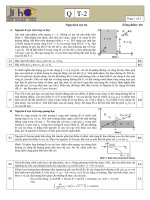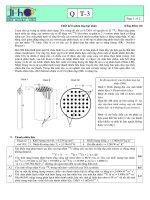- Trang chủ >>
- Khoa học xã hội >>
- Báo chí
De thi vat li quoc te IPHO nam 20044
Bạn đang xem bản rút gọn của tài liệu. Xem và tải ngay bản đầy đủ của tài liệu tại đây (183.39 KB, 6 trang )
<span class='text_page_counter'>(1)</span><div class='page_container' data-page=1>
<b>Theoretical Question 2: </b><i><b>Rising Balloon </b></i>
<b>1. Answers</b>
(a)
<i>P</i>
<i>P</i>
<i>P</i>
<i>ng</i>
<i>M</i>
<i>F<sub>B</sub></i> <i><sub>A</sub></i>
∆
+
=
(b) γ =
0
0
0
<i>P</i>
<i>g</i>
<i>z</i>
ρ
= 5.5
(c) ∆<i>P</i>=
− <sub>7</sub>
0
1
1
4
λ
λ
κ
<i>r</i>
<i>RT</i>
2 3 4 5
0.1
0.2
0.3
0.4
0.5
0.6
(d) <i>a</i>=0.110
</div>
<span class='text_page_counter'>(2)</span><div class='page_container' data-page=2>
<b>2. Solutions</b>
<b>[Part A] </b>
(a) [1.5 points]
Using the ideal gas equation of state, the volume of the helium gas of <i>n</i> moles at
pressure <i>P</i>+∆<i>P</i> and temperature <i>T</i> is
)
/(<i>P</i> <i>P</i>
<i>nRT</i>
<i>V</i> = +∆ (a1)
while the volume of <i>n</i>' moles of air gas at pressure <i>P</i>and temperature <i>T</i> is
<i>P</i>
<i>RT</i>
<i>n</i>
<i>V</i> = ' / . (a2)
Thus the balloon displaces
<i>P</i>
<i>P</i>
<i>P</i>
<i>n</i>
<i>n</i>
∆
+
=
' moles of air whose weight is <i>M<sub>A</sub>n</i>' . <i>g</i>
This displaced air weight is the buoyant force, i.e.,
<i>P</i>
<i>P</i>
<i>P</i>
<i>ng</i>
<i>M</i>
<i>F<sub>B</sub></i> <i><sub>A</sub></i>
∆
+
= . (a3)
(Partial credits for subtracting the gas weight.)
(b) [2 points]
The pressure difference arising from a height difference of <i>z</i> is −ρ<i>gz</i> when the air
density ρ is a constant. When it varies as a function of the height, we have
<i>g</i>
<i>T</i>
<i>P</i>
<i>P</i>
<i>T</i>
<i>g</i>
<i>dz</i>
<i>dP</i>
0
0
0
ρ
ρ =−
−
= (b1)
where the ideal gas law ρ<i>T</i>/<i>P</i> = constant is used. Inserting Eq. (2.1) and
0
0 1 /
/<i>T</i> <i>z</i> <i>z</i>
<i>T</i> = − on both sides of Eq. (b1), and comparing the two, one gets
52
.
5
10
01
.
1
8
.
9
10
9
.
4
16
.
1
5
4
0
0
0 <sub>=</sub>
×
×
×
×
=
=
<i>P</i>
<i>g</i>
<i>z</i>
ρ
γ . (b2)
The required numerical value is 5.5.
<b>[Part B] </b>
(c) [2 points]
The work needed to increase the radius from <i>r</i> to <i>r</i>+<i>dr</i> under the pressure
difference ∆<i>P</i> is
<i>Pdr</i>
<i>r</i>
</div>
<span class='text_page_counter'>(3)</span><div class='page_container' data-page=3>
<i>dr</i>
<i>r</i>
<i>r</i>
<i>r</i>
<i>RT</i>
<i>dr</i>
<i>dr</i>
<i>dU</i>
<i>dW</i> 4 (4 4 <sub>5</sub> )
6
0
−
=
= πκ . (c2)
Equating the two expressions of <i>dW</i> , one gets
)
1
(
4 <sub>7</sub>
6
0
<i>r</i>
<i>r</i>
<i>r</i>
<i>RT</i>
<i>P</i>= −
∆ κ =
− <sub>7</sub>
0
1
1
4
λ
λ
κ
<i>r</i>
<i>RT</i>
. (c3)
This is the required answer.
The graph as a function of λ (>1) increases sharply initially, has a maximum at λ=71/6
=1.38, and decreases as <sub>λ</sub>−1<sub> for large</sub><sub>λ</sub><sub>. The plot of </sub> <sub>/(</sub><sub>4</sub> <sub>/</sub> <sub>)</sub>
0
<i>r</i>
<i>RT</i>
<i>P</i> κ
∆ is given below.
2 3 4 5
0.1
0.2
0.3
0.4
0.5
0.6
(d) [1.5 points]
From the ideal gas law,
0
0
0
0<i>V</i> <i>n</i> <i>RT</i>
<i>P</i> = (d1)
where <i>V</i><sub>0</sub> is the unstretched volume.
At volume <i><sub>V</sub></i> <sub>=</sub><sub>λ</sub>3<i><sub>V</sub></i><sub>0</sub><sub> containing </sub><i><sub>n</sub></i><sub> moles, the ideal gas law applied to the gas inside </sub>
at <i>T</i> =<i>T</i><sub>0</sub> gives the inside pressure <i>P</i><sub>in</sub> as
0
3
0
0
in / <i><sub>n</sub></i> <i>P</i>
<i>n</i>
<i>V</i>
<i>nRT</i>
<i>P</i>
λ
=
= . (d2)
On the other hand, the result of (c) at <i>T</i> =<i>T</i><sub>0</sub> gives
in
<i>P</i> = <sub>7</sub> <sub>7</sub> <sub>0</sub>
0
0
0
0 ))
1
1
(
1
(
)
1
1
(
4
<i>P</i>
<i>a</i>
<i>r</i>
<i>RT</i>
<i>P</i>
<i>P</i>
<i>P</i>
λ
λ
λ
λ
κ
−
+
=
−
+
=
∆
+ . (d3)
</div>
<span class='text_page_counter'>(4)</span><div class='page_container' data-page=4>
7
1
3
0 ) 1
/(
−
− <sub>−</sub>
−
=
λ
λ
λ
<i>n</i>
<i>n</i>
<i>a</i> . (d5)
Inserting <i>n</i>/<i>n</i><sub>0</sub>=3.6 and λ=1.5 here, <i>a</i>=0.110.
<b>[Part C] </b>
(e) [3 points]
The buoyant force derived in problem (a) should balance the total mass of <i>M</i><sub>T</sub>=1.12 kg.
Thus, from Eq. (a3), at the weight balance,
<i>P</i>
<i>P</i>
<i>P</i>
∆
+ =<i>M</i> <i>n</i>
<i>M</i>
<i>A</i>
T <sub>. (e1) </sub>
On the other hand, applying again the ideal gas law to the helium gas inside of volume
0
3
3
0
3
3
3
4
3
4
<i>V</i>
<i>r</i>
<i>r</i>
<i>V</i> = π =λ π =λ , for arbitrary ambient <i>P</i> and <i>T</i>, one has
0
0
0
0
3
)
(
<i>n</i>
<i>n</i>
<i>T</i>
<i>T</i>
<i>P</i>
<i>V</i>
<i>nRT</i>
<i>P</i>
<i>P</i>+∆ λ = = (e2)
for <i>n</i> moles of helium. Eqs. (c3), (e1), and (e2) determine the three unknowns <i>P</i>,
<i>P</i>
∆ , and λ as a function of <i>T </i>and other parameters. Using Eq. (e2) in Eq. (e1), one
has an alternative condition for the weight balance as
0
T
3
0
0 <i>M</i> <i>n</i>
<i>M</i>
<i>T</i>
<i>T</i>
<i>P</i>
<i>P</i>
<i>A</i>
=
λ . (e3)
Next using (c3) for ∆<i>P</i> in (e2), one has
0
0
0
6
2
0
3 4 <sub>(</sub><sub>1</sub> <sub>)</sub>
<i>n</i>
<i>n</i>
<i>T</i>
<i>T</i>
<i>P</i>
<i>r</i>
<i>RT</i>
<i>P</i><sub>λ</sub> + κ <sub>λ</sub> −<sub>λ</sub>− =
or, rearranging it,
)
1
( 6
2
0
3
0
0
−
−
−
= λ λ
λ <i>a</i>
<i>n</i>
<i>n</i>
<i>T</i>
<i>T</i>
<i>P</i>
<i>P</i>
, (e4)
where the definition of <i>a</i> has been used again.
Equating the right hand sides of Eqs. (e3) and (e4), one has the equation for λ as
)
1
( 6
2 <sub>−</sub><sub>λ</sub>−
λ = 1 ( T)
0 <i>MA</i>
<i>M</i>
<i>n</i>
<i>an</i> − =4.54. (e5)
The solution for λ can be obtained by
54<sub>λ</sub>2 <sub>≈</sub>4.54/(1<sub>−</sub>4.54−3)<sub>≈</sub>4. <sub>: </sub> <sub>≅</sub>
<i>f</i>
</div>
<span class='text_page_counter'>(5)</span><div class='page_container' data-page=5>
To find the height, replace (<i>P</i>/<i>P</i><sub>0</sub>)/(<i>T</i>/<i>T</i><sub>0</sub>) on the left hand side of Eq. (e3) as a
function of the height given in (b) as
0
T
3
1
0
3
0
0
)
/
1
(
<i>n</i>
<i>M</i>
<i>M</i>
<i>z</i>
<i>z</i>
<i>T</i>
<i>T</i>
<i>P</i>
<i>P</i>
<i>A</i>
<i>f</i>
<i>f</i> =
−
= −<sub>λ</sub>
λ γ <sub>=3.10 . (e7) </sub>
Solution of Eq. (e7) for <i>z<sub>f</sub></i> with λ<i><sub>f</sub></i>=2.13 and γ −1=4.5 is
<i>f</i>
<i>z</i> = 49<sub>×</sub>
(
<sub>1</sub><sub>−</sub><sub>(</sub><sub>3</sub><sub>.</sub><sub>10</sub><sub>/</sub><sub>2</sub><sub>.</sub><sub>13</sub>3<sub>)</sub>1/4.5)
<sub>= 10.9 (km). </sub> <sub> </sub> <sub>(e8) </sub></div>
<span class='text_page_counter'>(6)</span><div class='page_container' data-page=6>
<b>3. Mark Distribution </b>
No. Total
Pt.
Partial
Pt. Contents
0.5 Archimedes’ principle
0.5 Ideal gas law applied correctly
(a) 1.5
0.5 Correct answer (partial credits 0.3 for subtracting He weight)
0.8 Relation of pressure difference to air density
0.5 Application of ideal gas law to convert the density into pressure
0.5 Correct formula for γ
(b) 2.0
0.2 Correct number in answer
0.7 Relation of mechanical work to elastic energy change
0.3 Relation of pressure to force
0.5 Correct answer in formula
(c) 2.0
0.5 Correct sketch of the curve
0.3 Use of ideal gas law for the increased pressure inside
0.4 Expression of inside pressure in terms of <i>a</i> at the given conditions
0.5 Formula or correct expression for <i>a</i>
(d) 1.5
0.3 Correct answer
0.3 Use of force balance as one condition to determine unknowns
0.3 Ideal gas law applied to the gas as an independent condition to determine
unknowns
0.5 The condition to determine λ<i><sub>f</sub></i> numerically
0.7 Correct answer for λ<i><sub>f</sub></i>
0.5 The relation of <i>z<sub>f</sub></i> versus λ<i><sub>f</sub></i>
(e) 3.0
</div>
<!--links-->









